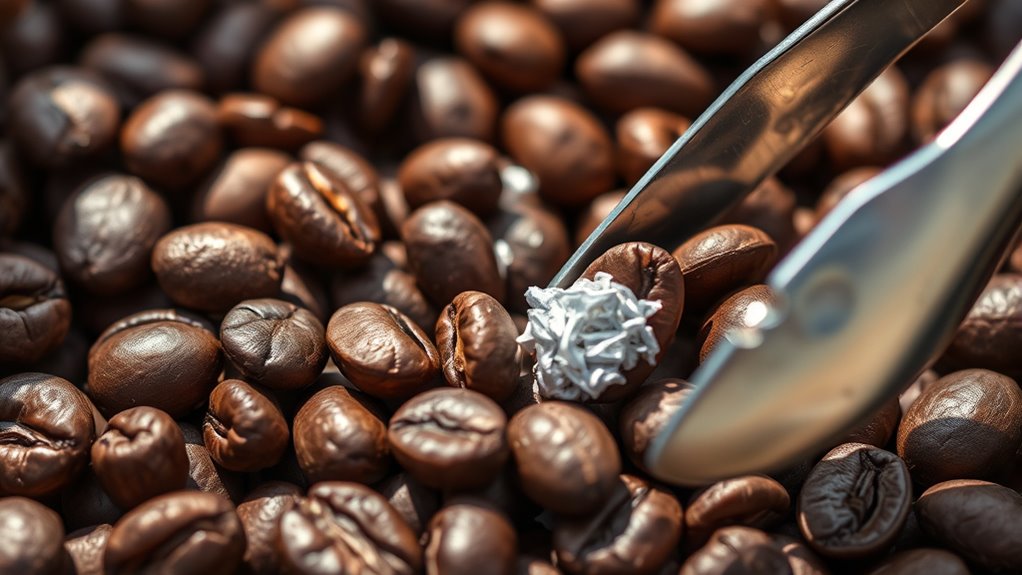Silverskin forms during roasting as tiny, papery layers loosen from the coffee beans due to internal pressure, expansion, and moisture turning to steam. If not removed, these fragments can cling to beans or escape into your cup, causing grit, bitterness, and muddled flavors. Roasters use various techniques to eliminate silverskin, ensuring a cleaner, more refined brew. Curious about how these methods improve your coffee experience? Keep exploring for the full details.
Key Takeaways
- Silverskin loosens from coffee beans during roasting due to internal pressure and expansion, often detaching as tiny fragments.
- Mechanical agitation and heat cause silverskin to break free and cling to beans or escape into ground coffee.
- During brewing, residual silverskin particles can pass through filters, ending up in the final cup.
- Roasters use techniques like shaking, sieving, and air-blasting to remove silverskin for a cleaner bean surface.
- Removing silverskin improves flavor clarity, reduces bitterness, and ensures a purer, higher-quality coffee experience.
The Formation of Silverskin During Roasting
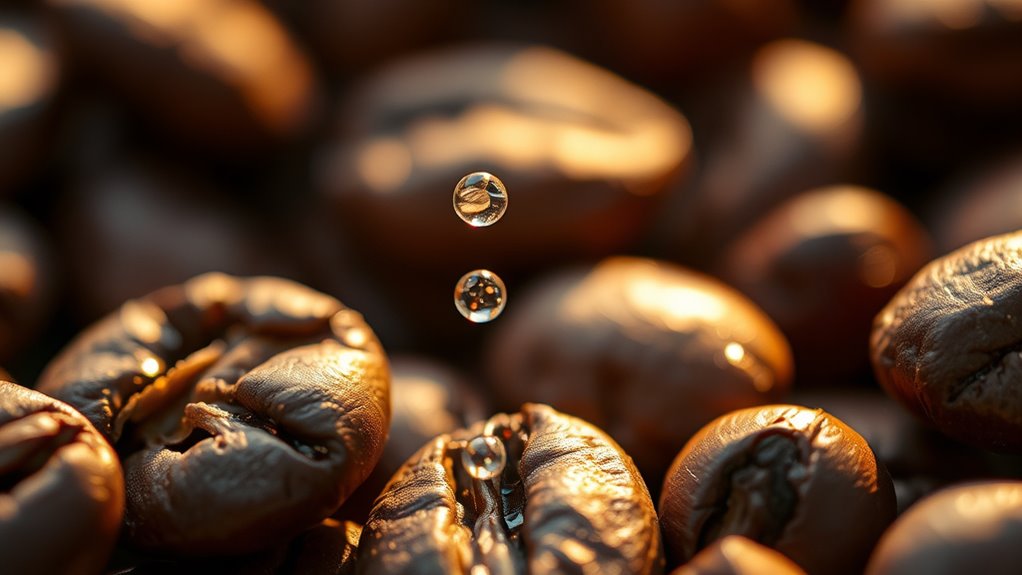
During roasting, silverskin forms as the coffee beans heat up and undergo physical changes. Understanding coffee bean anatomy helps clarify this process; silverskin is a thin, papery layer that wraps around the bean’s surface. As heat penetrates the bean, moisture escapes, and the bean expands, causing the silverskin to loosen. This skin becomes more visible as the roast progresses, especially during the first crack. The formation of silverskin is a natural part of the roasting process, but it can cling tightly to the beans, making silverskin removal necessary. Roasters pay close attention during this stage because proper silverskin removal guarantees a cleaner brew and better flavor extraction. Recognizing how silverskin forms helps you appreciate why removing it is a key step in coffee processing. Additionally, the presence of silverskin can influence the quality of the roast, which is why its removal is essential for achieving the desired flavor profile.
How Silverskin Breaks Free From Coffee Beans
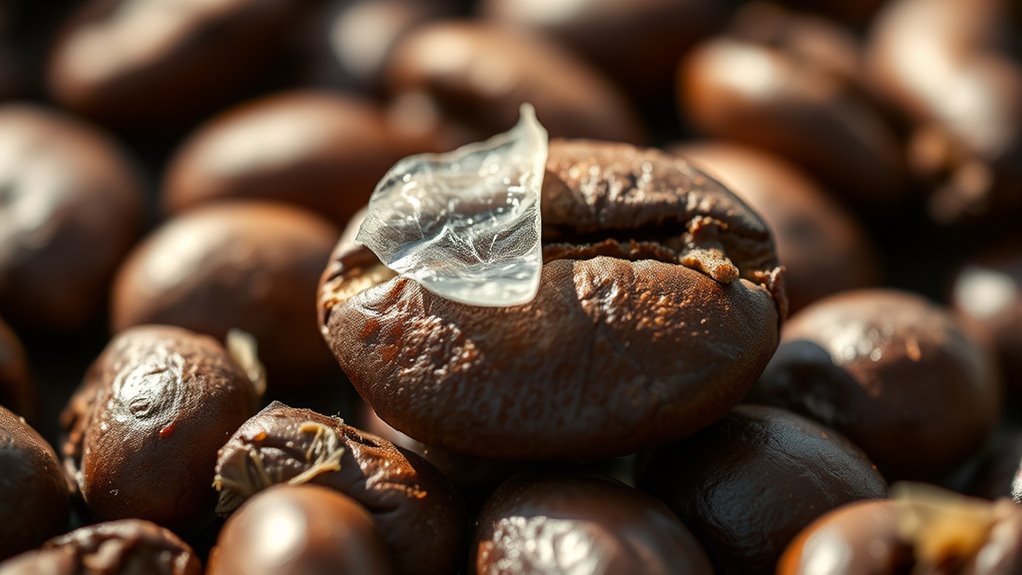
As roasting progresses and the bean heats up, the silverskin begins to loosen from the surface. This natural process causes tiny fragments to detach, especially as internal pressure builds. Handling green coffee storage carefully helps minimize premature silverskin loss before roasting. When beans are stored properly, the silverskin stays attached longer, reducing dust inside coffee bean packaging. During roasting, the heat causes the silverskin to crack and separate due to expansion and internal tension. As the bean’s moisture turns to steam, it creates enough force to free the silverskin from the surface. You’ll notice small flakes falling away as the roast intensifies. This process is a key step in preparing beans for brewing, ensuring that most silverskin has already broken free before grinding. Proper storage conditions can help maintain the integrity of the silverskin during the entire process.
The Journey of Silverskin Through Roasting and Brewing
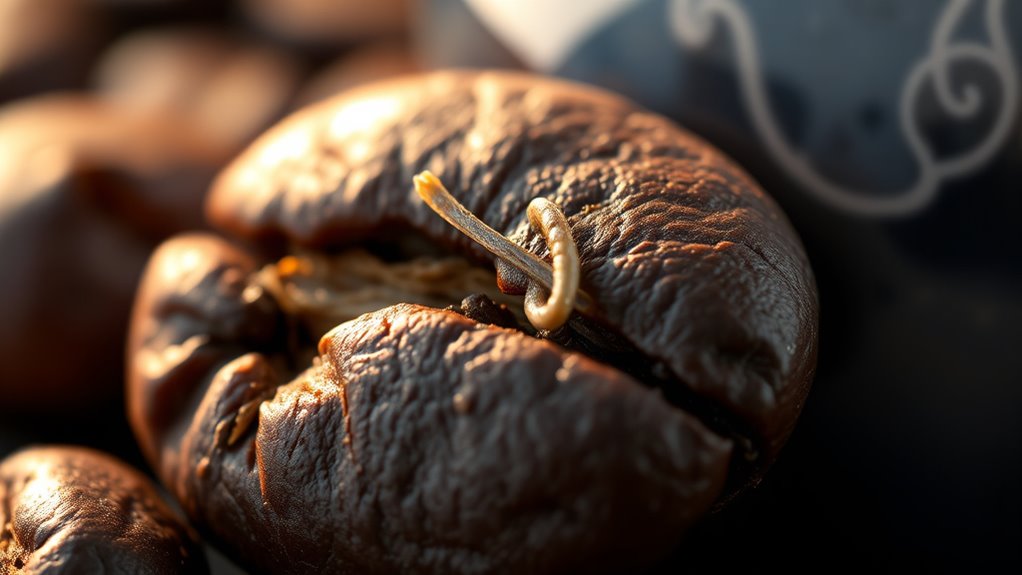
As the beans heat up during roasting, their outer layer transforms and releases silverskin. When you brew your coffee, this thin layer continues its journey, often ending up in your cup or filter. Understanding how roasting and filtration affect silverskin helps you appreciate its role in your coffee experience.
Beans’ Outer Layer
Have you ever wondered what happens to the silverskin—the thin outer layer of coffee beans—during roasting and brewing? During bean processing, this fragile layer naturally separates from the coffee bean. As roasting begins, heat causes the silverskin to loosen, and some pieces fall away. While most are removed to improve flavor, tiny bits can cling to the bean or escape during grinding. When brewing, these remnants often end up in your cup, contributing to the overall experience. Here’s a deeper look at their journey:
| Stage | Effect on Silverskin | Result for Coffee |
|---|---|---|
| Bean processing | Removes most silverskin | Cleaner flavor |
| Roasting | Loosens silverskin | Some fall away, some stay |
| Grinding | Releases tiny pieces | Possible in brew |
| Brewing | Extracts into cup | Silverskin particles present |
| Serving | Consumed with coffee | Texture and flavor influence |
Roasting Transformation Process
During roasting, heat causes the silverskin to loosen from the coffee bean, setting it on a path of transformation. The journey begins with agricultural harvesting, where beans are carefully collected to preserve quality. Proper storage conditions—cool, dry, and airtight—prevent silverskin from prematurely falling off. As roasting progresses, the intense heat causes moisture inside the bean to evaporate, creating pressure that forces the silverskin to separate. This process varies depending on the roast level; lighter roasts retain more silverskin, while darker roasts often shed it completely. The silverskin’s detachment is a natural part of roasting, but roasters aim to minimize it in the final product, as excess silverskin can impact flavor extraction during brewing.
Brewing and Filtration
Ever wondered how silverskin continues to influence your coffee even after roasting? During brewing, tiny silverskin particles can mix with the grounds, affecting caffeine extraction and brewing clarity. If not eliminated properly, these remnants can make your coffee appear cloudy or muddy, reducing overall flavor clarity. As water passes through the coffee bed, silverskin can either stay suspended or cling to grounds, impacting extraction rates. Proper filtration, like using paper filters or carefully designed brewers, helps trap these particles effectively. This process is essential for maintaining the authentic flavor profile of your coffee. Removing silverskin during brewing maintains your coffee’s purity, allowing you to enjoy the full spectrum of aroma and taste without distraction.
Impact of Silverskin on Coffee Flavor and Quality
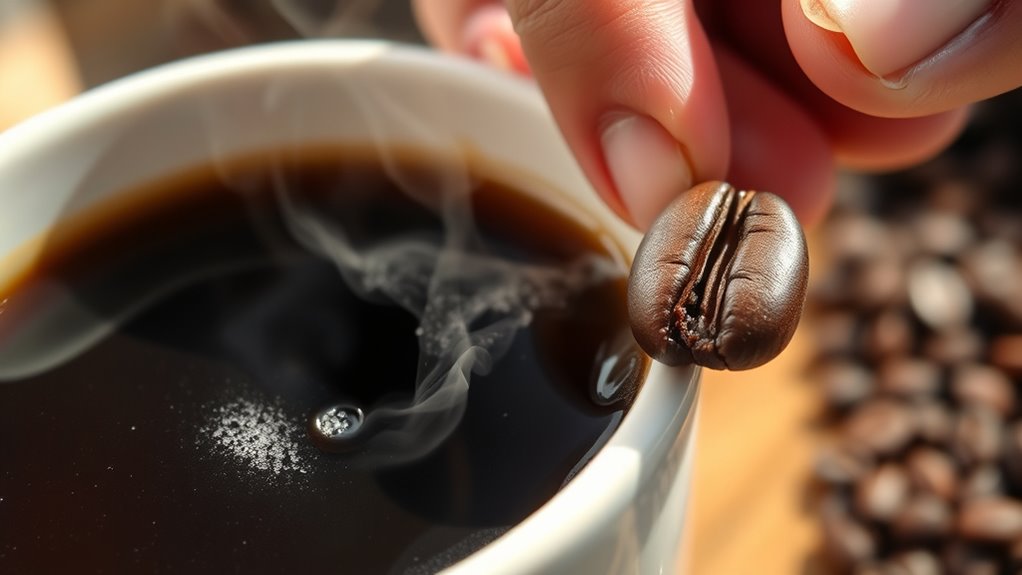
Silverskin, the thin layer that remains attached to coffee beans after roasting, considerably influences the flavor and overall quality of your brew. When silverskin stays attached, it can contribute to flavor enhancement by adding subtle, nuanced notes that deepen the coffee’s complexity. Additionally, it impacts sensory clarity, helping define the distinct characteristics of different beans. However, if too much silverskin remains, it can cause a gritty texture and introduce unwanted bitterness, dulling the overall flavor profile. Roasters carefully manage silverskin to preserve these positive qualities while minimizing negative effects. Removing it ensures a cleaner, more refined cup, allowing the true flavors of the coffee to shine through. Proper sourcing and manufacturing processes are essential to maintaining consistency in how silverskin is handled during processing. Ultimately, silverskin’s presence can either enhance or hinder your coffee’s flavor and quality, depending on how it’s handled.
Techniques Used by Roasters to Remove Silverskin
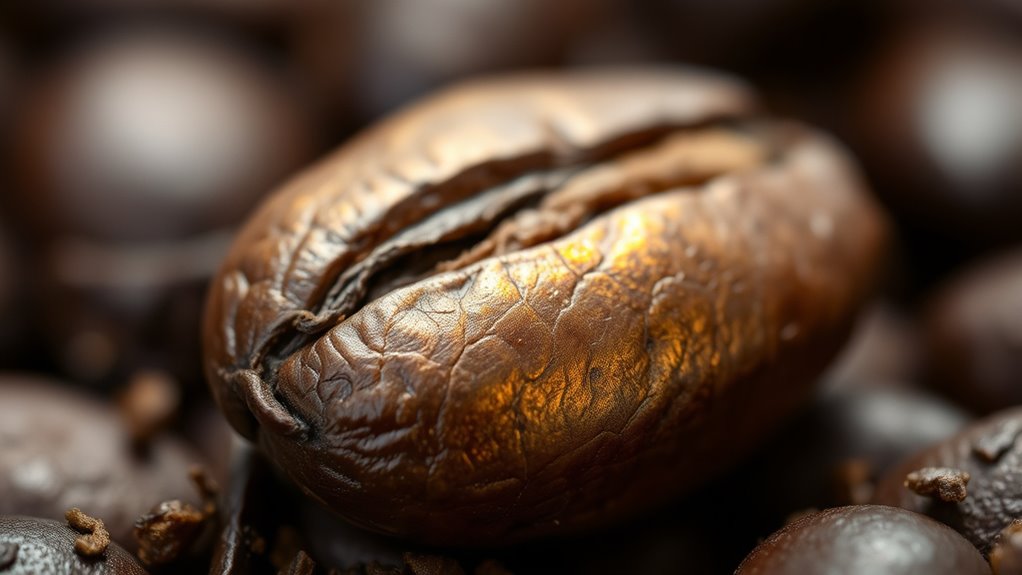
Roasters employ various techniques to effectively remove silverskin from coffee beans, ensuring a cleaner and more refined brew. One common method is mechanical agitation during roasting, where the heat causes the silverskin to loosen and fall away naturally. After roasting, some roasters use air-blasting machines that blow away loose silverskin particles, especially when beans are still warm. Proper bean storage also plays a role; storing beans in airtight containers prevents moisture buildup that can cause silverskin to cling more tightly. When packaging the roasted beans, skilled roasters often use gentle shaking or sieving to remove residual silverskin before sealing. These techniques help produce a purer bean surface, reducing the likelihood of silverskin ending up in your cup.
Benefits of Eliminating Silverskin for the Perfect Brew

Removing silverskin before brewing guarantees your coffee tastes cleaner and more consistent. Silverskin can trap unwanted flavors influenced by coffee bean genetics, which affect acidity and body. When silverskin is present, it can introduce bitter or sour notes that mask the coffee’s true profile. Eliminating it aligns with current market trends favoring clarity and purity in coffee flavors. By removing silverskin, you also reduce uneven extraction, ensuring your brew is balanced and smooth. This process highlights the coffee’s natural characteristics, whether fruity, nutty, or floral. For specialty coffee enthusiasts, eliminating silverskin enhances the sensory experience, making every cup more satisfying. Additionally, using proper extraction techniques ensures that the removal process complements the brewing method and optimizes flavor. In today’s competitive market, those who prioritize purity gain a distinct edge, delivering a cleaner, more refined brew every time.
Frequently Asked Questions
Does Silverskin Affect the Caffeine Content of Brewed Coffee?
Silverskin doesn’t considerably affect caffeine extraction or the flavor impact in your brewed coffee. It’s a thin layer that typically stays with the beans during roasting and grinding, so it doesn’t alter the caffeine content you get in your cup. Roasters remove it mainly to improve flavor clarity and prevent bitterness, but its presence doesn’t change the amount of caffeine you consume. So, rest assured, silverskin isn’t a caffeine concern.
Can Silverskin Be Present in Pre-Roasted Coffee Beans?
Like dust on a mirror, silverskin can be present on pre-roasted coffee beans, as processing residue clings to bean surface layers. You might find tiny silverskin fragments before roasting begins, but roasting usually burns or removes most of it. Roasters aim to eliminate this residue to improve flavor and brewing quality, so if you see silverskin on raw beans, know it’s common and part of the natural processing process.
Is Silverskin Removal Necessary for All Coffee Brewing Methods?
You might wonder if silverskin removal is necessary for all brewing methods. It depends on processing methods and equipment compatibility; some methods, like espresso, benefit from removing silverskin to avoid bitterness and clogging. Others, like French press, can handle it better. Ultimately, understanding your brewing equipment and the processing techniques used helps determine whether silverskin removal enhances your coffee experience.
How Does Silverskin Influence the Coffee’s Aroma During Brewing?
Think of silverskin as a delicate veil that influences your coffee’s aroma during brewing. It can hinder flavor enhancement and aroma preservation, making your brew less vibrant. When silverskin remains, it may introduce bitter or grainy notes, dulling the aroma you seek. By removing it, you allow the true fragrance and flavor to shine, ensuring your coffee’s aroma is preserved and your cup delivers a richer, more aromatic experience.
Are There Health Concerns Associated With Consuming Silverskin?
You might wonder about the health implications of consuming silverskin. Generally, silverskin isn’t harmful and poses no significant health concerns when ingested in small amounts. However, since it’s a natural part of coffee, it can affect dietary considerations if you’re sensitive to fiber or have allergies. While it’s safe for most, it’s wise to be mindful of how it fits into your overall diet, especially if you have specific health conditions.
Conclusion
So, even though silverskin ends up in your cup, it’s actually a sign that your roaster’s doing their job. Ironically, what’s meant to add flavor can sometimes ruin it, reminding you that perfection often comes from what’s been carefully removed. Next time you enjoy that smooth brew, remember—it’s the tiny, hidden bits they’ve sifted out that truly make the difference. Sometimes, less really is more in your perfect cup.
